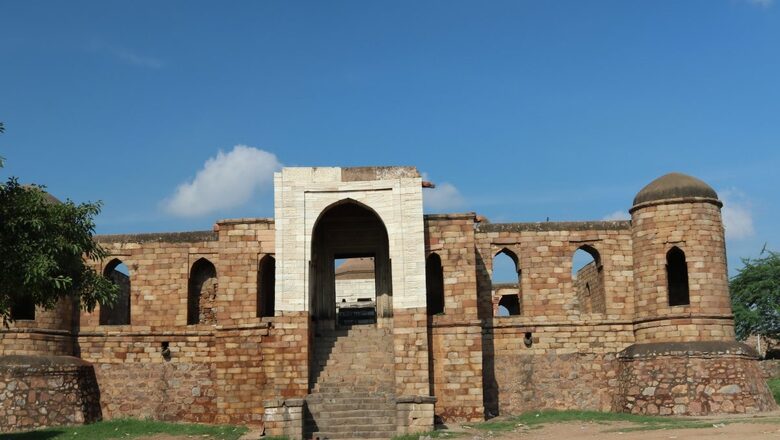
views
During a very lively discussion this week at the Delhi Art Gallery on the conservation of monuments, pegged on an exhibition of exquisite aquatints of north India by William Hodges, a question by a girl that stumped the panellists and many in the audience concerned a building that the 18th-century British landscape artist had not painted at all. But in the context of the imminent event at Ayodhya on January 22, the relevance of the query was undeniable.
The panellists—conservation architects Abha Narain Lambah, Vikas Dilawari and Manish Chakraborti with historian Swapna Liddle as the moderator—supported local participation in managing at least some monuments instead of blanket state control. They concurred that the Archaeological Survey of India and state counterparts isolated monuments by enclosing them within boundary walls so the people living nearby were not emotionally invested in them.
Though the jury is still out on whether preservation should mean extensive restoration, a girl in the audience asked whether a monument like, say, south Delhi’s Sultan Ghari—not among the many Islamic buildings of northern India painted by Hodges between 1780 and 1783—be left in the hands of locals as some of them believe it had been built atop the debris of a temple? She feared communal polarisation if they got to decide on its conservation.
Dr Liddle’s prompt but inaccurate assertion that there was no proof of a temple at that spot, sidestepped a knotty fact brought up by the girl’s question: that many monuments in India have contested antecedents. However, a ‘history’ of Sultan Ghari—now accepted by both communities—could well be the answer to the problem of contestations elsewhere in India, as people around it appear to have found a “belief” that is equally compatible with their different faiths.
There’s no gainsaying peoples’ beliefs, especially in India as very few can be traced back to definite causes or incidents. Histories or interpretations of events change with time and even according to political and social exigencies. Similar names and circumstances often add to the mystery. That can be a boon or bane depending on how narratives and beliefs evolve and are managed. The Sultan Ghari complex with its many unexplained aspects, is a case in point.
Many locals say—and believe, presumably—that the 13th-century tomb is the resting place of a ‘Pir Baba’, a Sufi mystic. Today Muslims and Hindus from nearby villages offer flowers and other oblations at the three graves in the octagonal underground chamber. However, not only is there no definite data on how long this syncretic custom has been around, but local residents also have no details about this medieval Pir Baba, including his actual name.
At the same time, several international experts have noted that the pillars in the cloisters as well as other architectural elements in the tomb and mosque within the fortified bastion have been ‘reused’ from ‘earlier’ buildings, which could only have been temples, given the motifs. Monuments in the Mehrauli complex, which are roughly contemporary to Sultan Ghari, also bear evidence of the destruction of existing temples, and there is even an inscription saying exactly that.
So, the builders of Sultan Ghari may have done the same, particularly as a beam retrieved from there in the 1960s (now in the National Museum in New Delhi) bears three floral motifs that indicate a non-Islamic provenance. Though scholars disagree about whether it is from a Buddhist building or a Gurjara-Pratihara (9th-11th century) style temple, no one doubts it is not Islamic. If the rubble-packing used in the plinth is excavated, what lies beneath may be epiphanic.
The ASI website post on Sultan Ghari dates it to 1231, saying it was built by the Mamluk Sultan Iltutmish for his eldest son Nasiruddin Mahmud who died suddenly in 1229 while he was governor of Bengal. But, confusingly, another son (or grandson) of Iltutmish with exactly the same name reigned from 1246 to 1265. Another Nasiruddin Mahmud, born after the death of the others, was better known as Chirag-e-Dilli, the 14th-century Sufi disciple of Nizamuddin Auliya!
The ASI adds, “The ceiling [of Sultan Ghari] rests on columns raised with two pillars each robbed from an earlier Hindu shrine; carved lintels from another were found embedded in the thick lime-concrete roof. Other pieces were used in the ceilings of the prayer chamber and bastions and pillars re-utilised in the verandahs, originally used as a madrasa, after chipping the decoration off them. The tomb was repaired by Firuz Shah Tughluq.” No mention of a Pir.
According to the Tabaqat-I-Nasiri (a 23-volume history of dynasties completed in 1260 by Minhaj-i-Siraj Juzjani during the reign of the later prince with the same name) Nasiruddin Mahmud—called Abul Fath Mahmud—is described as a “beneficent, intelligent, sensible and sagacious prince endowed with great energy and gallantry, and was munificent and benevolent.” No inkling of any Sufi spirituality that could have led to the prince being regarded as a Pir.
The eminent Pakistani archaeologist SAA Naqvi in an ASI paper written just before Independence says the first mention of the name ‘Sultan Ghari’ was in 1845 by Syed Ahmed Khan, who did not cite any source for the contention. Naqvi also says Nasiruddin “fought several wars and by his acts endeared himself to his co-religionists”, adding that “every year on the seventeenth day of the month of Ziqat, his Urs is celebrated and the shrine is thronged with pilgrims.”
He does not allude to Iltutmish’s son and heir having any Pir Baba-type aura nor mention that the annual Urs celebrations included Hindus. Nor, for that matter, does he refer to the current “custom” of Muslims and Hindus from nearby areas going there every Thursday—also called Guruvaar—with offerings, as is done for Sai Baba. So, when and how did the medieval Muslim warrior prince morph into a syncretic mystic whose tomb is now an interfaith ‘shrine’?
There is a distinctly apocryphal story involving a prescient slave girl telling Nasiruddin “You will never be a king of the land but will be the king of souls.” On the other hand, the ‘shrine’ definitely includes spolia of pre-Islamic buildings, probably Hindu and Jain. Why would the tomb of a prince who supposedly believed in harmony be built with remnants of destroyed structures of other faiths? Could the syncretic ‘shrine’ theme be a coping device?
Turning an unknown Mamluk prince into a pan-denominational figure of reverence gives adherents of both faiths reason to frequent that spot rather than only one. People—rather than courts—arriving at a mutually acceptable dual-use formula seems a less fractious, more mature and intelligent way to deal with the reality of India’s history—and its complicated architectural legacy. How Sultan Ghari’s modus vivendi evolved must be researched. And emulated.
Two things are apparent. First, denying a contested history is not helpful. Second, leaving monuments—disputed or otherwise—to the secular mercy of ASI is not a great option. The panellists at DAG were very correct indeed on that count. Ditto for the ‘courts will decide’ route. Sultan Ghari shows that local people, on their own, can and do find ways to achieve mutual acceptance as they have to ultimately live together around potentially eristic monuments.
The author is a freelance writer. Views expressed in the above piece are personal and solely that of the author. They do not necessarily reflect News18’s views.


















Comments
0 comment